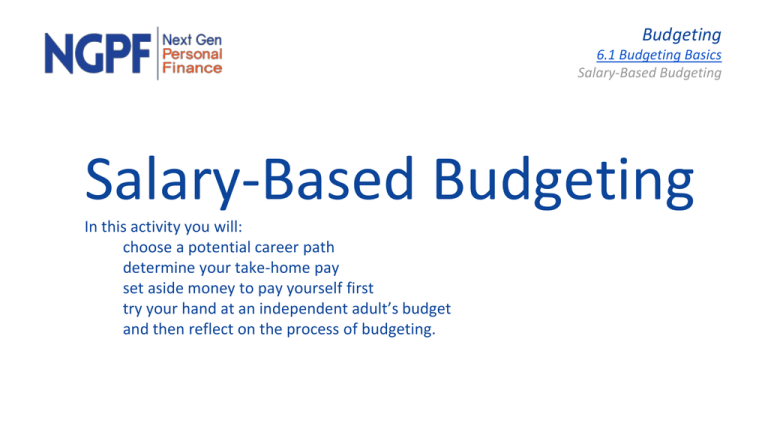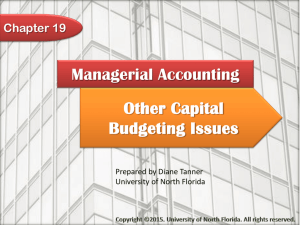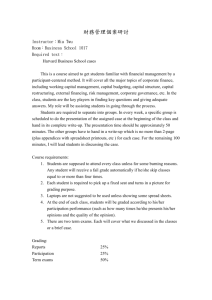Budgeting 6.1 Budgeting Basics Salary-Based Budgeting
advertisement

Budgeting 6.1 Budgeting Basics Salary-Based Budgeting Salary-Based Budgeting In this activity you will: choose a potential career path determine your take-home pay set aside money to pay yourself first try your hand at an independent adult’s budget and then reflect on the process of budgeting. Budgeting 6.1 Budgeting Basics Salary-Based Budgeting STEP 1: Open the Salary-Based Budgeting worksheet, then click File → Make a copy Name your worksheet “LAST NAME, FIRST INITIAL budget” Close the original Salary-Based Budgeting worksheet Use your copy of the worksheet to record all the work for this project. Budgeting 6.1 Budgeting Basics Salary-Based Budgeting STEP 2: Visit the US Department of Labor’s Bureau of Labor Statistics. To locate your preferred future career: ● Pick a category and look for the job OR ● Use the “Find” feature and type in a keyword for the career you want. o To use “Find”, you can click “Edit” along the top of your screen and go to “Find”, OR you can hold CTRL+F (Command+F for Mac users) Once you find your career, record the “Annual Mean Wage” on your budget worksheet (aka your Annual Gross Wage) Budgeting 6.1 Budgeting Basics Salary-Based Budgeting STEP 3: Calculate your monthly Gross Wage. Gross Wage (monthly) = Annual Gross Wage / 12 Record on your budget spreadsheet. *While “wage” and “salary” are different (in how your are paid), for this activity both refer to the money earned from working **From this point on, you’ll use MONTHLY amounts for all budget entries. Budgeting 6.1 Budgeting Basics Salary-Based Budgeting STEP 4: Use the ADP Salary Paycheck Calculator to find your Net Pay (the wage you actually take home each month, after deductions). To do the activity correctly, choose the state you’ll be living in and then use these values: Gross Pay = Your Gross Wage (monthly) → PER PAY PERIOD Pay Frequency = Monthly Federal Filing Status = single (unless you’re married) # of federal allowances = 1 (unless you have dependent children) Leave all other values as they are. Record “Net Pay” on budget spreadsheet under “Net Wage (monthly)” Budgeting 6.1 Budgeting Basics Salary-Based Budgeting STEP 5: “Pay yourself first” by putting aside a percent of your net salary into a savings account. Choose one of the percents below, and calculate how much you’ll be saving off your net salary. 5% → this is low, but better than nothing 10% → this is a good goal for your first career; increase later 15% → terrific savings goal! Savings = Net Wage (monthly) * % savings (remember 5% = .05) Budgeting 6.1 Budgeting Basics Salary-Based Budgeting STEP 6: It’s never too young to start saving for retirement. You want to set aside another portion of your net salary to put toward retirement. 5% → this is low, but better than nothing 10% → this is a good goal for your first career; increase later 15% → terrific retirement goal! Retirement = Net Salary (monthly) * % retirement (5% = .05) Budgeting 6.1 Budgeting Basics Salary-Based Budgeting STEP 7: Calculate the total amount you’re saving each month. Total Monthly Savings = Monthly Savings Account + Monthly Retirement Budgeting 6.1 Budgeting Basics Salary-Based Budgeting STEP 8: Calculate the monthly amount you have to budget. **Savings is NOT an expense; it’s the money you’re setting aside for your own future. However, it’s also money that you shouldn’t spend on other things each month, so it gets taken out BEFORE you do your monthly budget. Monthly Amount to Budget = Net Salary (monthly) - Total Savings Budgeting 6.1 Budgeting Basics Salary-Based Budgeting STEP 9: RENT To determine how much you will spend on rent, choose the type of living situation you see yourself in. Option A: Live at home Option B: Live in an apartment/house by yourself Option C: Live in an apartment/house with roommates Go to the slide for your choice to determine your rent cost. Budgeting 6.1 Budgeting Basics Salary-Based Budgeting STEP 9A: RENT (Live at home) Option 1: If you’re planning to live at home or with other relatives, estimate how much they’re going to charge you per month. Better yet, ASK! Do not assume they’ll let you live rent free! Record the answer in Monthly Rent. If you’re planning to live on your own or with roommates, continue on. Budgeting 6.1 Budgeting Basics Salary-Based Budgeting STEP 9B: RENT (Live in an apartment/house by yourself ) If you want to live completely on your own, use the website Rent o Meter to calculate your Monthly Rent: a) In ADDRESS, input the city you would like to live in after college. b) Under RENT/MO., input how much you would like to pay per month. Look at your Monthly Amount to Budget and be sure not to spend more than 25% on Housing. c) Select STUDIO OR ONE BEDROOM under Bedrooms. d) Select "ANALYZE MY RENTAL" e) On next page, RENTAL COMPARISON Page, you will find average rental rates in your desired city. Either use the average rent price, or a figure in the 20th/80th range for your city. Keep in mind that your apartment will be nicer if you choose at the high end of the range and less nice if you choose at the low end (in general). Budgeting 6.1 Budgeting Basics Salary-Based Budgeting STEP 9C: RENT (Live in an apartment/house with roommates) Option 3: If you are willing to live with roommates ($ saving!), use the website Rent o Meter to calculate your Monthly Rent: a) In ADDRESS, input the city you would like to live in after college. b) Under RENT/MO., input how much you would like to pay per month. Look at your Monthly Amount to Budget and be sure not to spend more than 25% on Housing. c) Select # of BEDROOMS based on total number of people living there (you + roommates) d) Select "ANALYZE MY RENTAL" e) On next page, RENTAL COMPARISON Page, you will find average rental rates in your desired city. Either use the average rent price, or a figure in the 20th/80th range for your city. Monthly Rent = rent price / # of people living there Budgeting 6.1 Budgeting Basics Salary-Based Budgeting STEP 10: Renter’s Insurance You want to have renter’s insurance, to cover replacement of your belongings in case of theft or apartment-wide damage (flood, fire, etc). Unless you have a lot of expensive stuff, you can budget $20 for Renter’s Insurance. Budgeting 6.1 Budgeting Basics Salary-Based Budgeting STEP 11a: Utilities ● If you’re living with family, they may expect you to chip in full or partial amounts. (Ask what you owe) ● If you’re living on your own, you’ve got to pay the full costs. ● With roommates, you get to split a lot (but not all) of these costs. o Remember to divide those bills by the # of people! Budgeting 6.1 Budgeting Basics Salary-Based Budgeting STEP 12: Calculate your total monthly budget for the cost of living. Cost of Living = Rent + Renter’s Insurance + Cable/Satellite + Internet + Home Phone + Mobile Phone + Electricity/Gas Budgeting 6.1 Budgeting Basics Salary-Based Budgeting STEP 13: Public Transportation (Busses, Trains, etc.) ● If you’re living in a city that allows you to get where you need via Public Transportation, and you’re not going to have a car at all, use one of the figures below: New Orleans, Los Angeles $90 Honolulu, New York $135 Chicago $105 Washington, DC $195 Miami, Sanwill Francisco **If you only $120 I’m going to use to a car instead use public transportation, skip Step 18 $0 Budgeting 6.1 Budgeting Basics Salary-Based Budgeting STEP 14: Car Payment ● If you’re going to have a car, choose one of the following Car Payments (3 year loan, 4.75%): $8,000 car -- $240/mo **If youcar are using public $20,000 -- $600/mo $10,000 car -- $300/mo $15,000 -- $450/mo transportation, pay $0 for a car $30,000 car --you $900/mo $45,000 -- $1340/mo Budgeting 6.1 Budgeting Basics Salary-Based Budgeting STEP 15: Car Insurance Assume between $164 (good rate, no accidents/violations, or less coverage) and $333 per month (worse rate, accidents/violations, or premo coverage)-- you must be insured! STEP 16: Car Maintenance Assume $100 per month -- some months will be $0, but some will be expensive! Budgeting 6.1 Budgeting Basics Salary-Based Budgeting STEP 17: Gas Estimate how many miles you’ll drive per day and use this chart to find your gas prices (based on $3.55/gallon and 23.6mi/gallon): Miles Per Day Monthly Cost of Gasoline 25 $113 35 $158 45 $203 Budgeting 6.1 Budgeting Basics Salary-Based Budgeting STEP 18: Calculate your total monthly budget for transportation. Cost of Transportation = Public Transportation + Car Payment + Car Insurance + Car Maintenance + Gas Budgeting 6.1 Budgeting Basics Salary-Based Budgeting STEP 19: Choose which meal plan you’re likely to follow for the cost of Groceries: Thrifty Low Cost Moderate Cost Liberal Cost Females $167 $211 $259 $332 Males $188 $242 $303 $373 Budgeting 6.1 Budgeting Basics Salary-Based Budgeting STEP 20: Choose which plan you’re likely to follow for the cost of Dining Out: $10/meal $15/meal $20/meal $30/meal 1 meal/week $40 $60 $80 $120 2 meals/week $80 $120 $160 $240 3 meals/week $120 $180 $240 $360 5 meals/week $200 $300 $400 $600 Budgeting 6.1 Budgeting Basics Salary-Based Budgeting STEP 21: Calculate your total monthly budget for food. Cost of Food = Groceries + Eating Out Budgeting 6.1 Budgeting Basics Salary-Based Budgeting Calculate the cost of your insurance STEP 22: Health Insurance o If you are single: Average $999/yr o Remember to divide by 12 to get the monthly cost STEP 23: Dental Insurance - $25/month STEP 24: Vision Insurance - $25/month Budgeting 6.1 Budgeting Basics Salary-Based Budgeting STEP 25: Haircare If you already know how much you pay for a haircut, enter it. If you’re not sure, use the US averages: Men $28 Women $44 **If you only get a haircut every 3 months, divide the cost by 3. STEP 26: Other Grooming/Hygiene Everyone’s different, but let’s assume $25/mo for other hygiene, medication, grooming, or personal needs. Budgeting 6.1 Budgeting Basics Salary-Based Budgeting STEP 27: Gym Membership Remember, the first step to wealth is health! If you don’t workout, or you do it free outside or at home, $0. Otherwise, assume $58/mo for a gym membership. Budgeting 6.1 Budgeting Basics Salary-Based Budgeting STEP 28: Calculate your total monthly budget for health. Cost of Health = Health Insurance + Dental Insurance + Vision Insurance + Haircuts + Other Grooming/Hygiene + Gym Membership Budgeting 6.1 Budgeting Basics Salary-Based Budgeting STEP 29: Student Loan Payments If you did not go to any post-high school schooling, or you somehow did so without any student loan debt, congrats on paying $0/month! Otherwise, choose your best estimate based on how much debt you’ll have when done with college or other post-high school education: Debt $10,000 $20,000 $30,000 $40,000 $50,000 Monthly Loan Payment $115 $230 $345 $460 $575 Budgeting 6.1 Budgeting Basics Salary-Based Budgeting STEP 30: Discretionary Spending So far, your budget is neglecting FUN STUFF (clothes, going out with friends, entertainment, new technology, gift giving, donations, travel, vacations, a morning coffee, etc). In the Wants category, record how much you’d like to be able to spend on these items (total) per month. Budgeting 6.1 Budgeting Basics Salary-Based Budgeting STEP 31: Monthly Spending It’s time to figure out how much you’re spending each month: Total Costs = Cost of Living + Transportation + Food + Health + Student Loan + Wants Budgeting 6.1 Budgeting Basics Salary-Based Budgeting STEP 32: Balance At the end of the month, how do your finances look? ● Do you spend less than you earn? You have a surplus, or money left over -- that’s good! ● Do you spend more than you have in your budget? You have a deficit, or expenses not covered by your earnings -- that’s bad! Balance = Monthly Amount for Budget - Total Costs Budgeting 6.1 Budgeting Basics Salary-Based Budgeting Now that you’ve done the budget once through, you have a basic understanding of the components of a typical adult’s budget. Next, continue on to the Salary-Based Budgeting Reflection (next resource in this lesson). Use your Salary-Based Budgeting Worksheet and this presentation as reference.






